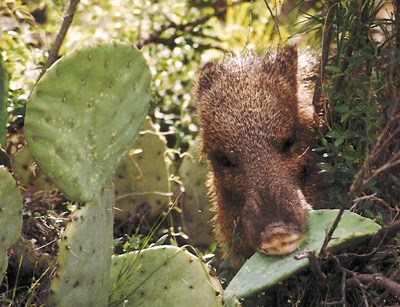
NPS Photo/Cookie Ballou The collared peccary (Tayassu tajacu), commonly known as the javelina, is found as far south as Argentina and as far north as Texas, New Mexico, and Arizona. Collared peccaries are in the even-toed, hoofed mammal order of Artiodactyla. Javelina are mistaken for pigs, but they are in a different family than pigs. There are several differences between the two animals, detailed below:

Javelina feed by spreading out in a loosely knit group. As they day heats up, they seek shelter in cooler canyons, caves, and areas of dense shrub. They will feed again in late afternoon until dark. Feeding time increases in cooler months and resting time increases in the summer. Javelina may even feed at night during the hottest months. After feeding, the band will bed down under rocky overhangs, in caves, and in shallow depressions with heavy brush cover. They will huddle together in a group for warmth and protection. Javelina can breed any month of the year, but most births occur in May, June, or July, after a five-month gestation period. This corresponds with the summer rainy season. They first breed at about one year of age and continue to breed throughout their lifetime. Females give birth standing up and nurse the young for two months. The average litter size is two, but occasionally is as high as five. By six weeks of age the young are capable of eating solid food. By forty weeks, the young are full-grown. There is typically a 50% or higher mortality rate for the young. Coyotes, bobcats, black bears, and mountain lions prey on javelinas. On average, javelina live 7 years in the wild. Javelina live in groups (or bands), but do not form long-term pair bonds. Band size ranges from five to twenty-seven animals, with an average of fourteen per band in Big Bend National Park. Javelina hides were shipped east and to Europe for gloves and hairbrushes in the late 1800's and early 1900's. The hides were used as barter in many trading posts along the U.S./ Mexico border. Since the 1940's, javelina have been considered a sporting game animal in Texas, providing income for landowners and the State of Texas by way of hunter's fees. Within Big Bend National Park, javelina are protected. |
Last updated: July 5, 2020
